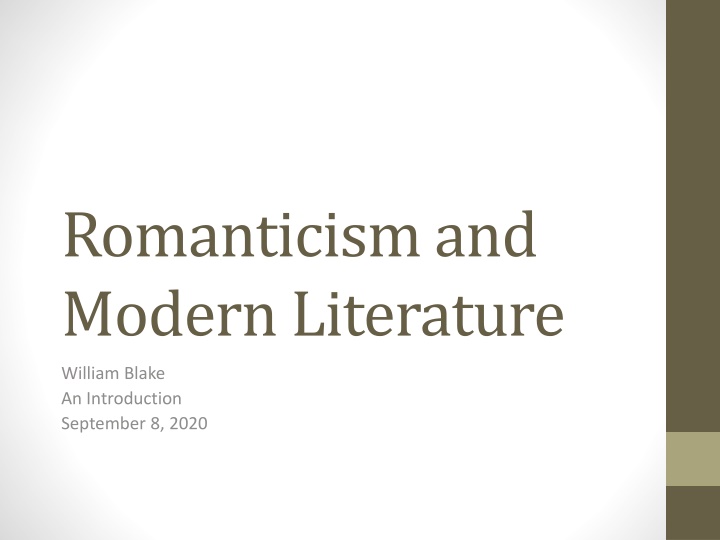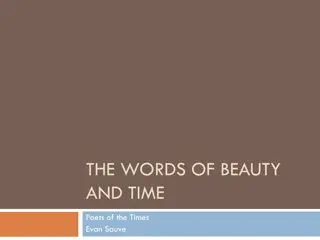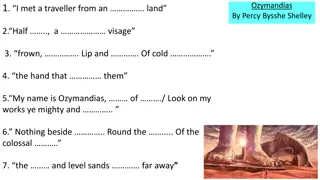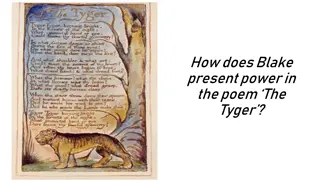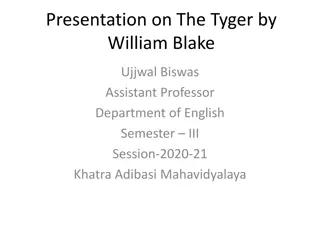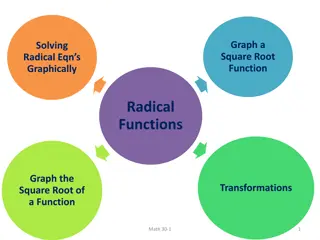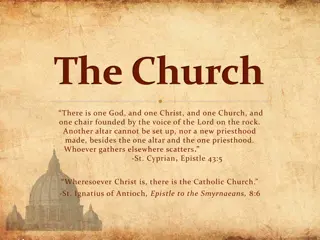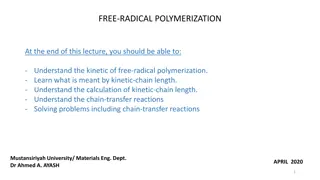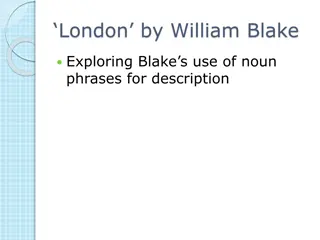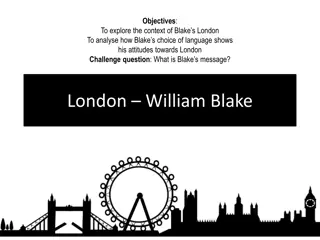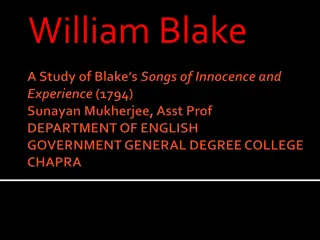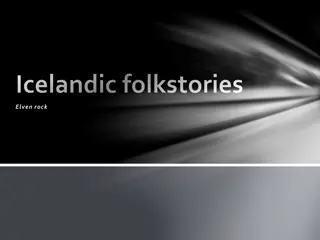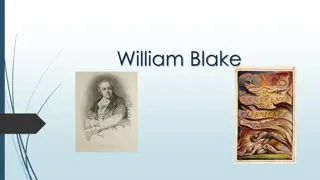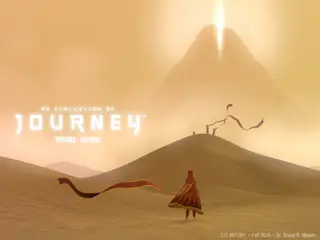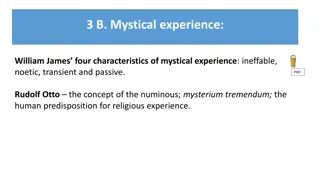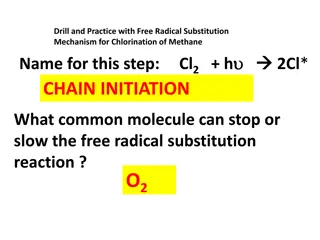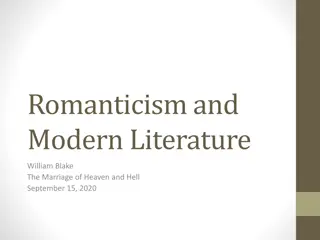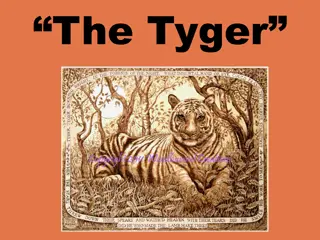William Blake: Mystical Visionary and Radical Artist
William Blake, a mystical poet, artist, and radical thinker, explored the depths of human consciousness through his visionary works. From his mystical experiences to his revolutionary ideals, Blake's art and poetry challenged traditional norms and embraced the duality of innocence and experience. Dive into the world of this enigmatic figure who left a lasting impact on Romanticism and modern literature.
Download Presentation

Please find below an Image/Link to download the presentation.
The content on the website is provided AS IS for your information and personal use only. It may not be sold, licensed, or shared on other websites without obtaining consent from the author.If you encounter any issues during the download, it is possible that the publisher has removed the file from their server.
You are allowed to download the files provided on this website for personal or commercial use, subject to the condition that they are used lawfully. All files are the property of their respective owners.
The content on the website is provided AS IS for your information and personal use only. It may not be sold, licensed, or shared on other websites without obtaining consent from the author.
E N D
Presentation Transcript
Romanticism and Modern Literature William Blake An Introduction September 8, 2020
Blake as a Mystic He claimed when he was young that he saw a tree filled with angels returning home. When his brother John died, Blake records how he beheld his spirit ascending and 'clapping its hands for joy'. Thereafter, Blake claimed to hold contact with his spirit 'daily and hourly'; he heard 'his advice and even now write from his dictate. At the age of 14, he was taken to William Ryland, then a highly respected engraver to be apprenticed under him, but he said I do not like the man s face: it looks as if he will live to be hanged. And he was indeed hanged after 12 years. He was once under a strong influence of Emanuel Swedenborg, a visionary Swedish Theologian, whom he rejected after recognizing him a conventional Angel in the disguise of a radical Devil. The Marriage of Heaven and Hell was the result of his renunciation of Swedenborgism. Romanticism and Modern Literature Slide 02 2
Blake as a Radical Blake himself participated briefly in the Gordon Riots of 1780 when he was supposedly 'forced to go in the very front rank and witness the destruction of Newgate [prison]. John Flaxman, then the most famous sculptor in Europe, became his best friend and many of his coterie were radicals. Invited to Joseph Johnson s house, Blake met William Godwin, Joseph Priestly, Mary Wollstonecraft, and Thomas Paine. One legend says that Blake saved Paine s life by warning him of his impeding arrest. An altercation with one John Schofield, a private in the Royal Dragoons who accused Blake of Damning the King. Blake was acquitted only with a strong support from William Hayley his former patron he had really hated. Romanticism and Modern Literature Slide 02 3
Blake's "illuminated painting" Blake s technique was to produce his text and design on a copper plate with and impervious liquid. The plate was then dipped in acid so that the text and design remained in relief. That plate could be used to print on paper, and the final copy would be then hand colored. Romanticism and Modern Literature Slide 02 4
The Songs of Innocence and of Experience The poems show the two Contrary States of the Human Soul "Innocence" and "Experience" are definitions of consciousness that rethink Milton's existential-mythic states of "Paradise" and the "Fall. Childhood is a state of protected innocence rather than original sin, but not immune to the fallen world and its institutions. This world sometimes impinges on childhood itself, and in any event becomes known through "experience," a state of being marked by the loss of childhood vitality, by fear and inhibition, by social and political corruption, and by the manifold oppression of Church, State, and the ruling classes. Romanticism and Modern Literature Slide 02 5
The French Revolution(1791) This poem was intended to be seven books in length, but only one book survives. (in manuscript only) In that book, Blake describes the problems of the French monarchy and seeks the destruction of the Bastille in the name of Freedom. Blake celebrates the rise of democracy in France and the fall of the monarchy. King Louis represents a monarchy that is old and dying. The sick king is lethargic and unable to act From my window I see the old mountains of France, like aged men, fading away. The voice of the people demands the removal of the king s troops from Paris, and their departure at the end of the first book signals the triumph of democracy. Romanticism and Modern Literature Slide 02 6
The Marriage of Heaven and Hell(1793) It is a series of texts written in imitation of biblical prophecy but expressing Blake's own intensely personal Romantic and revolutionary beliefs. The title is an ironic reference to Emanuel Swedenborg's theological work Heaven and Hell, published in Latin 33 years earlier. The book is written in prose, except for the opening "Argument" and the "Song of Liberty". (Menippean Satire) The book describes the poet's visit to Hell, a device adopted by Blake from Dante's Inferno and Milton's Paradise Lost. Romanticism and Modern Literature Slide 02 7
America(1793) Blake addresses the idea of revolution, but the poem is less a commentary on the actual revolution in America as it is a commentary on universal principles that are at work in any revolution. The fiery figure of Orc represents all revolutions. Romanticism and Modern Literature Slide 02 The fiery joy, that Urizen perverted to ten commands, What night he led the starry hosts thro the wide wilderness, That story law I stamp to dust; and scatter religion abroad To the four winds as a torn book, & none shall gather the leaves. (line 3-6 Plate 8) 8
Minor Prophesies(1794-5) Europe(1794), The First Book of Urizen(1794), The Book of Los(1795), The Book of Ahania(1795) Blake examines the fall of man. In Blake's mythology man and God were once united, but man separated himself from God and became weaker and weaker as he became further divided. Throughout the poems Blake writes of the destructive aspects of this separation into warring identities. Romanticism and Modern Literature Slide 02 9
Urizen representing reason" that part of mind that constantly defines and limits human thought and action. Urizen s repressive laws bring only further chaos and destruction Romanticism and Modern Literature Slide 02 10
Los Poetic Genius, divided from Urizen representing the part of the human mind forging the creative aspects of the mind into works of art. Also a limiter, but productive and necessary Romanticism and Modern Literature Slide 02 11
Enitharmon Los's female form after it's separation into a male and a female forms. She gives a birth to Orc who gives some hope for radical change in a fallen world. Romanticism and Modern Literature Slide 02 12
Orc the coming of Orc is likened not only to the fires of revolution sweeping Europe, but also to the final apocalypse when the "Grave shrieks with delight." Romanticism and Modern Literature Slide 02 13
Ahania Urizen's female form after his further division into male and female. Ahania is only a sin in that she is given that name. Romanticism and Modern Literature Slide 02 14
Milton(1804) Its ostensible subject is the poet Jon Milton, but the author, William Blake, also creates a character for himself in his own poem. Blake examines the entire range of mental activity involves in the art of poetry from the initial inspiration of the poet to the reception of his vision by the reader of the poem. Milton examines as part of its subject the very nature of poetry. What it means to be a poet, what a poem is, and what it means to be a reader of poetry. In the preface to the poem, Blake issues a battle cry to his readers to reject what is merely fashionable in art: Romanticism and Modern Literature Slide 02 15
A Quotation from Milton Rouze up, O Young Men of the New Age! Set your foreheads against the ignorant Hirelings! For we have Hirelings in the Camp, the Court & the University, who would, if they could, for ever depress Mental & prolong Corporeal War. Painters! On you I call. Sculptors! Architects! Suffer not the fashionable Fools to depress your powers by the prices they pretend to give for contemptible works, or the expensive advertizing boasts that they make of such works; believe Christ & his Apostles that there is a Class of men whose whole delight is in Destroying. We do not want either Greek or Roman Models if we are but just & true to our own imaginations, those Worlds of Eternity in which we shall live for ever in Jesus our Lord. Romanticism and Modern Literature Slide 02 16
Jerusalem(1804) Blake s major achievement, an epic poem consisting of 100 illuminated plates. Blake develops his mythology to explore man s fall and redemption. As the narrative begins, man is apart from God and split into separate identities. As the poem progresses man s split identities are unified, and man is reunited with divinity that is within him. Much of Jerusalem is devoted to the idea of awakening the human senses, so that the reader can perceive the spiritual world that is everywhere present. Romanticism and Modern Literature Slide 02 17
A Quotation from Jerusalem To open the Eternal Worlds, to open the immortal Eyes Of Man inwards into the Worlds of Thought, into Eternity Ever expanding in the Bosom of God, the Human Imagination. (Plate 18, 5) Let every Christian, as much as in him lies, engage himself openly & publicly before all the World in some Mental pursuit for the Building up of Jerusalem. (from To the Christians at the beginning of Chapter 4) To build Jerusalem is to reconstruct man s fallen nature, so that he can grow closer to the divinity that is within him. Primarily this is to come about through the liberation of the senses, so that man can perceive eternity. Romanticism and Modern Literature Slide 02 18
